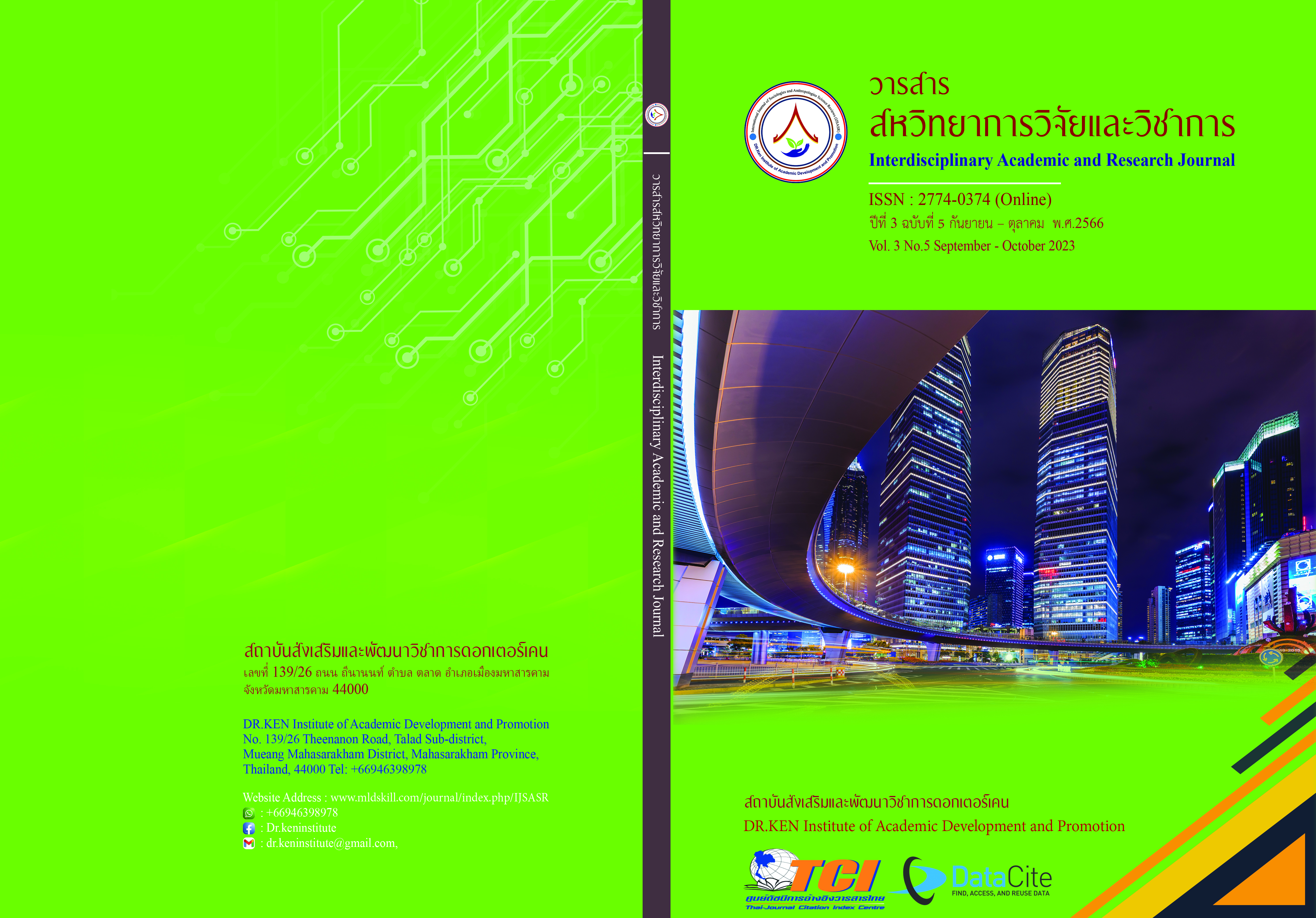การบริหารการสื่อสารในภาวะวิกฤตการระบาดโรคติดเชื้อไวรัสโคโรนา 2019 ผ่านเฟซบุ๊กเพจ ศูนย์ข้อมูลโควิด-19 ของกรมประชาสัมพันธ์
DOI:
https://doi.org/10.14456/iarj.2023.247คำสำคัญ:
การสื่อสารในภาวะวิกฤต; , การบริหารประเด็นในภาวะวิกฤต; , เฟซบุ๊กศูนย์ข้อมูลโควิด 19บทคัดย่อ
การระบาดโรคติดเชื้อไวรัสโคโรนา 2019 เป็นโรคอุบัติใหม่ หน่วยงานที่เกี่ยวข้อง ไม่สามารถให้คำตอบหรือแนวทางปฏิบัติที่ชัดเจนนัก ภายใต้ความไม่ชัดเจน ในการนำเสนอข้อมูลต่าง ๆ เป็นผลให้ข้อมูลข่าวสาร เต็มไปด้วยข้อมูลแนวทางที่หลากหลายซึ่งสร้างความสับสนและไม่ชัดเจน จึงต้องมีการศึกษาการบริหารการสื่อสารในภาวะวิกฤตการระบาดโรคติดเชื้อไวรัสโคโรนา 2019 ผ่านเฟซบุ๊กเพจ ศูนย์ข้อมูลโควิด-19 ของกรมประชาสัมพันธ์ การวิจัยนี้มีวัตถุประสงค์เพื่อศึกษา 1) กระบวนการสื่อสารในภาวะวิกฤตการระบาดโรคติดเชื้อไวรัส โคโรนา 2019 ผ่านเฟซบุ๊กเพจ ศูนย์ข้อมูลโควิด-19 ของกรมประชาสัมพันธ์ 2) วิธีการบริหารประเด็นการสื่อสารในภาวะวิกฤตการระบาดโรคติดเชื้อไวรัสโคโรนา 2019 ผ่านเฟซบุ๊กเพจ ศูนย์ข้อมูลโควิด-19 ของกรมประชาสัมพันธ์ และ 3) กลยุทธ์การบริหารประเด็นการสื่อสารในภาวะวิกฤตการระบาดโรคติดเชื้อไวรัสโคโรนา 2019 ของเฟซบุ๊กเพจ ศูนย์ข้อมูลโควิด-19 ของกรมประชาสัมพันธ์ ใช้วิธีการวิจัยเชิงคุณภาพ โดยการสัมภาษณ์เชิงลึก ผู้ให้ข้อมูลหลักเป็นผู้ที่เกี่ยวข้องกับการปฏิบัติงานด้านการสื่อสารของเฟซบุ๊กเพจ ศูนย์ข้อมูลโควิด-19 กรมประชาสัมพันธ์ จำนวน 12 คน เครื่องมือการวิจัย คือ แบบสัมภาษณ์เชิงลึกแบบกึ่งโครงสร้าง วิเคราะห์ข้อมูลด้วยวิธีการตีความและสร้างข้อสรุปในลักษณะของการบรรยายเชิงพรรณนา ผลการวิจัยพบว่า 1) ศูนย์ข้อมูล โควิด-19 มีการใช้เฟซบุ๊กเพจ “ศูนย์ข้อมูลโควิด-19”ทำหน้าที่เผยแพร่ข้อมูลข่าวสาร โดยมีกระบวนการสื่อสาร คือ (1) การกำหนดเป้าหมายการสื่อสารคือ การแจ้งนโยบายและความคืบหน้าของการขับเคลื่อนศูนย์ (2) การกำหนดกลุ่มเป้าหมายผู้รับสาร ออกเป็น 3 กลุ่ม คือ กลุ่มประชาชนทั่วไป กลุ่มวัยกลางคน และกลุ่มเฉพาะ (3) การกำหนดประเด็น โดยได้มาจากทำงานร่วมกันของหน่วยงานภาครัฐไม่น้อยกว่า 5 หน่วยงาน และมีกระบวนการตรวจสอบความถูกต้องก่อนการเผยแพร่ (4) การผลิตและเผยแพร่ข้อมูล โดยใช้ภาษาที่เข้าใจง่าย ตรงกลุ่มเป้าหมาย เพื่อให้สามารถนำไปปฏิบัติได้อย่างถูกต้อง (5) การประเมินผล โดยการรวบรวมความคิดเห็นและจำแนกประเด็นต่างๆ จากผู้รับสารที่ได้รับผลกระทบเพื่อปรับวิธีการและเนื้อหาสารให้สอดคล้องกับสถานการณ์ 2) การบริหารประเด็นการสื่อสาร โดย (1) การวิเคราะห์สถานการณ์เพื่อประเมินผลกระทบและความเสียหาย และประเมินการรับรู้ของกลุ่มผู้รับสารเกี่ยวกับโรคว่าอยู่ในภาวะของความตระหนักหรือการตื่นตระหนก (2) การกำหนดประเด็นหลักโดยมีที่มาจากการประชุมศูนย์ข้อมูล โควิด-19 และประเด็นรองมาจากทีมโฆษกศูนย์ ทั้งนี้มีการบริหารประเด็น ใน 3 กรณี คือ กรณีสถานการณ์ไม่รุนแรง เน้นการประชาสัมพันธ์เชิงรุก มีการวางแผนล่วงหน้า กรณีสถานการณ์รุนแรงเน้นการประชาสัมพันธ์เชิงรับ สื่อสารเชิงบวก เน้นย้ำถึงความร่วมมือ มีการประเมินการสื่อสารจากข่าวสารที่ถูกส่งต่อบนสื่อออนไลน์ และจัดลำดับตามความสนใจของประชาชนและสถานการณ์ และกรณีที่มีประเด็นที่นำไปสู่ความสับสน เน้นการให้ความรู้ เพิ่มความถี่การให้ข้อมูลเชิงบวก ไม่เจาะลึกประเด็นที่อาจสับสน (3) การวางแผนการปฏิบัติการนำเสนอประเด็นในแต่ละวัน โดยเน้นประเด็นองค์ความรู้เกี่ยวกับโรค ประเด็นความเสี่ยง ความพร้อมของระบบสาธารณสุขในประเทศ และประเด็นการแก้ปัญหาของภาครัฐ (4) การประเมินเพื่อปรับปรุงประเด็นจากผู้บริหาร และความคิดเห็นเชิงบวกเชิงลบของผู้รับสาร 3) กลยุทธ์การบริหารประเด็น พบว่า มีการใช้กลยุทธ์การตอบสนองอย่างมีพลวัตมากที่สุด ด้วยการทำสื่อในการรณรงค์ต่อประเด็นนั้นๆ มีการเพิ่มความถี่การนำเสนอเพื่อเพิ่มพื้นที่การมองเห็นในแต่ละช่วงสถานการณ์ มีการใช้ภาษาที่ง่ายต่อการจำเพื่อให้เกิดการโน้มน้าวใจ การเปลี่ยนแปลงทัศนคติ การบอกต่อ อย่างไรก็ตามกรณีที่มีการคัดค้าน ไม่ได้รับความร่วมมือ จะใช้วิธีการรอนโยบายจากผู้บริหาร การอ้างอิงเพิ่มความน่าเชื่อถือของข้อมูล กรณีที่มีความผันผวนสูงหรือเปลี่ยนแปลงอย่างรวดเร็ว มีหลักปฏิบัติ “ยอมรับ” และโพสต์ขอโทษชี้แจง และเพิ่มการใส่แหล่งอ้างอิง
เอกสารอ้างอิง
Choomb, W. (2015). Ongoing Crisis Communications: Planning, Managing, and Responding. 4th edition. Thousand Oaks, CA: Sage Publications.
Regester, M. & Larkin, J. (2005). Risk issues and crisis management. Milford, CT: Kogan.
Ulmer, S., Seeger, M. W. (2007). Effective Crisis Communication Moving from Crisis to Opportunity. California: Sage.
งานโรคติดต่ออุบัติใหม่ กลุ่มพัฒนาวิชาการโรคติดต่อ. (2564). สถานการณ์โรคติดเชื้อไวรัสโคโรนา 2019 (COVID-19) มาตรการสาธารณสุข และปัญหาอุปสรรคการป้องกันควบคุมโรคในผู้เดินทาง. Retrieved from: https://ddc.moph.go.th/uploads/files/2017420210820025238.pdf
ณิษาพัชร์ ประสงค์มงคล และสุภาภรณ์ ศรีดี. (2565). การสื่อสารในภาวะวิกฤตการระบาดโรคติดเชื้อไวรัส โคโรนา 2019 ผ่านเฟซบุ๊กไทยรู้สู้โควิด ของกระทรวงสาธารณสุข. Journal of Arts Management, 7(1), 227-247.
ปรีดี นุกุลสมปรารถนา. (2563). การสื่อสารในภาวะวิกฤต (Crisis Communication). Retrieved from: https://www.popticles.com/business/crisis-communication/
ปัณณวัชร์ พิชัยบวรภัสร์. (2560). กลยุทธ์การจัดการการสื่อสารในภาวะวิกฤตในยุคดิจิทัล กรณีศึกษากลุ่มธุรกิจการบินและบริการ: สายการบินยูไนเต็ด แอร์ไลน์สายการบินแอร์เอเชีย และสายการบินนกแอร์. วิทยานิพนธ์การศึกษาค้นคว้าอิสระปริญญามหาบัณฑิต: มหาวิทยาลัยกรุงเทพ.
วิรัช ลภิรัตนกุล. (2552). กลยุทธ์การประชาสัมพันธ์ในภาวะวิกฤตและการบริหารภาวะวิกฤต. กรุงเทพฯ:สำนักพิมพ์แห่งจุฬาลงกรณ์มหาวิทยาลัย.
วุฒินัน จันทร์มา. (2564). การจัดการการสื่อสารในภาวะวิกฤตไวรัสโคโรน่า 2019 ของสำนักประชาสัมพันธ์ เขต 7จันทบุรี. วิทยานิพนธ์ปริญญามหาบัณฑิต: มหาวิทยาลัยราชภัฏรำไพพรรณี.
สำนักงานการวิจัยแห่งชาติ. (2563). ปัญหาข่าวปลอมและขบวนการหลอกลวงในช่วงวิกฤตโควิด-19. Retrieved from: https://tdri.or.th/2020/02/covid-3/
สุธาวัลย์ โอสถเจริญ และ สันทัด ทองรินทร์. (2565). กลยุทธ์การนำเสนอข่าวสารในสื่อสารในเฟซบุ๊กของสำนักประชาสัมพันธ์ เขต 7 กรมประชาสัมพันธ์. วารสารนิเทศศาสตรปริทัศน์, 26(1), 167-177.
สุภาพร ครุสารพิศิฐ. (2565). การเชื่อมโยงข้อมูลข่าวสารและการประชาสัมพันธ์ของกรมประชาสัมพันธ์. Retrieved from: https://www.prd.go.th/th/file/get/file/20220617d41d8cd98f00b204e9800998ecf8427e100530.pdf
สุภาพร นิภานนท์. (2559). กลยุทธ์การสื่อสารและการบริหารประเด็นเพื่อผลักดัน นโยบายระบบสุขภาพมาตรฐานเดียว. วิทยานิพนธ์ปริญญามหาบัณฑิต: มหาวิยาลัยธรรมศาสตร์.
ดาวน์โหลด
เผยแพร่แล้ว
รูปแบบการอ้างอิง
ฉบับ
ประเภทบทความ
สัญญาอนุญาต
ลิขสิทธิ์ (c) 2023 Chalumphon Sonthi, Santat Thongrin, Monwipa Wongrujira

อนุญาตภายใต้เงื่อนไข Creative Commons Attribution-NonCommercial-NoDerivatives 4.0 International License.
ลิขสิทธิ์ในบทความใดๆ ใน Interdisciplinary Academic and Research Journal ยังคงเป็นของผู้เขียนภายใต้ ภายใต้ Creative Commons Attribution-NonCommercial-NoDerivatives 4.0 International License การอนุญาตให้ใช้ข้อความ เนื้อหา รูปภาพ ฯลฯ ของสิ่งพิมพ์ ผู้ใช้ใดๆ เพื่ออ่าน ดาวน์โหลด คัดลอก แจกจ่าย พิมพ์ ค้นหา หรือลิงก์ไปยังบทความฉบับเต็ม รวบรวมข้อมูลเพื่อจัดทำดัชนี ส่งต่อเป็นข้อมูลไปยังซอฟต์แวร์ หรือใช้เพื่อวัตถุประสงค์ทางกฎหมายอื่นใด แต่ห้ามนำไปใช้ในเชิงพาณิชย์หรือด้วยเจตนาที่จะเป็นประโยชน์ต่อธุรกิจใดๆ

















